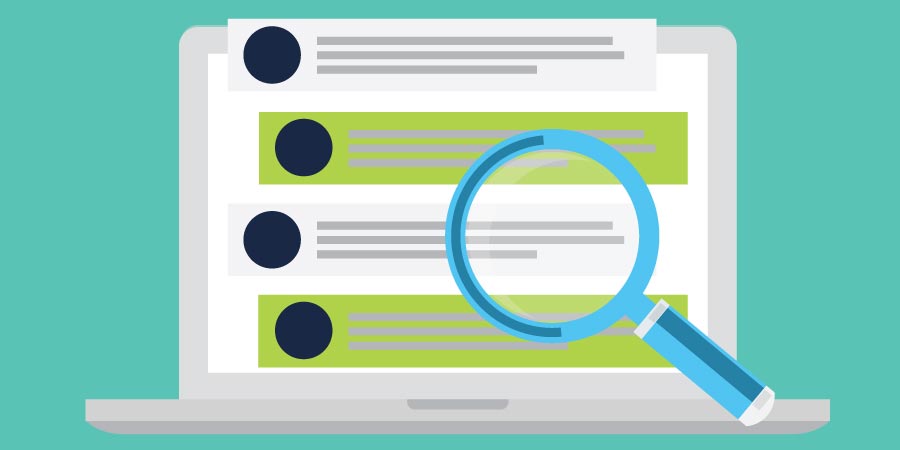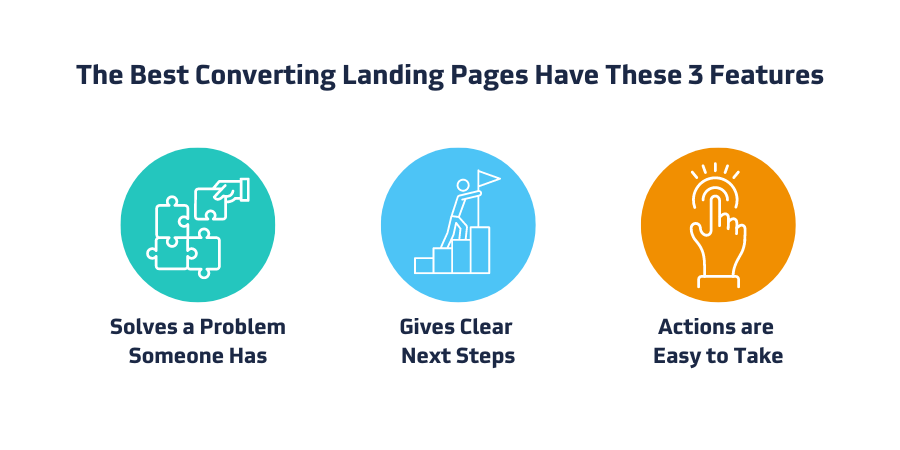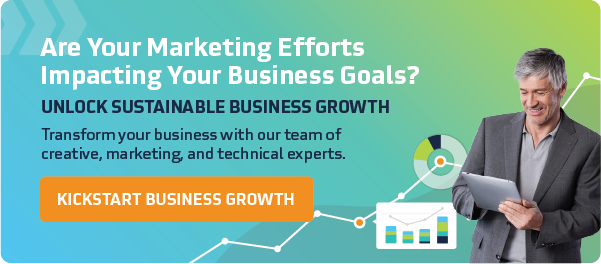Landing Page vs. Website: Which Will Maximize My Success?
 Krista
|
Krista
|

To maximize success, you must have effective website pages and landing pages on your website. Start by making decisions and actions based on traffic boosting, attempting to attract new leads, and essentially boosting traffic, attracting new leads, and connecting your message with your customers. Here, we will discuss landing and website pages more and how you can make a strategic plan to use both to make the most of your website and push your potential leads down your sales funnel.
Utilizing Your Website to Drive Revenue Growth
Websites are powerful tools to help your business establish credibility, increase sales, and improve conversion rates. You want to make a website that will provide the product perfectly so the consumers know what they are buying. A website plays a pivotal role in your overall marketing strategy, serving as the digital storefront of your business and providing a platform to engage with your target audience. It is instrumental in standing out from competitors, providing exceptional content, and driving conversions.
5 Ways Website Pages Maximize User Engagements
Brand Visibility and Credibility
Brand visibility and credibility are things that can make or break a business. When a buyer doesn’t see that you are a credible source, they will look elsewhere. A well-designed and informative website instills trust and credibility in your audience, reinforcing your brand's authority in your industry. Developing high trust between your customers and business will increase sales and customer loyalty.
Engage Audiences with Content Marketing
Content marketing can help you engage your audience and build relationships, boosting sales. Content marketing through blog posts, articles, and resource pages helps you attract and engage your target audience, positioning your brand as an industry leader. Content marketing can help with the trouble of building brand value. Content marketing helps grow brand awareness, which will help your high-quality products stay in the mix.
Lead Generation
Dedicated landing pages can be optimized to capture leads through forms, offering valuable resources or incentives in exchange for contact information. By reaching a more in-depth audience, your brand can see an increase in exposure and in this, you will reach a significantly higher set of potential customers who may have not been aware of your services and products. Failing to do so will slowly result in decreased leads and a loss in the marketplace, which then entails the loss of potential clients.
Conversion Pathways
Well-structured website pages guide visitors through a structured customer journey. This involves creating a clear call-to-action (CTAs) that leads visitors to take desired actions, such as signing up for a newsletter, requesting a quote, or purchasing. Overall when you focus on your customer's conversion paths this will help you determine how the visitors are engaging with your content and how you can optimize their path for high conversion rates and effectiveness.
Search Engine Optimization (SEO)
When you need to boost your website traffic, a great way to do so is by using SEO. With a solid, structured website, you can create easy navigation for your visitors. When you optimize for SEO, you will see increased organic impressions, traffic, and engagement. Increasing your website's pages per visit metric can have a direct correlation with Google search engine rankings. Google has been known to observe dwell time (a metric that can reflect strength in pages per visit) as a ranking factor.
Boost Your Website's Performance with These Must-have Pages

Homepage: Your homepage is the digital front door to your business. It should provide a snapshot of what your company offers, establish your brand identity, and guide visitors to explore other pages on your site. A great way to peak the interest of your visitors from the homepage is to provide a CTA which will pull people into your other pages on the side which can create a cycle of prospection.
Product or Service Pages: These pages offer in-depth information about your products or services. Include product descriptions, images, pricing, and relevant details that help potential customers make informed decisions.
About Us Page: An About Us page provides insight into your company's history, mission, values, and the people behind it. It helps build trust and connections with your audience. Use this page as a digital asset, allowing you to personalize your content and tell the story of your business how you see fit.
Contact Us Page: Make it easy for visitors to contact you. Include contact forms, phone numbers, and addresses to encourage inquiries and customer interactions. With a “Contact Us” page, this will give you the plan for your prospects to get in touch with you. This will guide new and existing customers on ways to get ahold of you, and you get the information from the provider to contact them in the future.
Testimonial and Review Pages: Showcase positive feedback from customers to build trust and credibility. Testimonials and reviews provide social proof and can influence purchase decisions. These pages improve engagement, a testimonial or review, and persuade someone that your product or service could impact their needs.
FAQ Pages: Frequently Asked Questions pages address common queries and alleviate potential concerns. They can improve user experience and help streamline customer support. When you improve the customer experience a, the customer will see what your product or service can do for them and will have their questions answered.

Resource Pages: Resource pages can house valuable content like ebooks, whitepapers, templates, and guides. Adding this content can showcase your brand identity, providing your brand's value to the marketplace. Keeping these pages fresh will provide a way to stand out from your competition. Offering these resources for free or in exchange for contact information can enhance lead generation efforts.
Dive Deep: Understanding Landing Pages
One of the most important attributes of a great landing page is the layout. When you have a clear layout, it will be easy to navigate and a breeze for your visitors to understand what is the main purpose of your page.
This landing page is a dedicated, action-oriented standalone web page, acting as the central hub for that specific marketing campaign. Its primary objective may include generating leads, driving sales, promoting a product or service, or encouraging visitors to take a particular action. The goal is to portray landing pages not as just a standalone digital tool, but as an integral component of your marketing efforts and strategy.
You can create multiple landing pages tailored to specific campaigns and exclude them from the main website navigation. Instead, visitors are directed to these pages through links or CTAs in emails, social media posts, or other marketing channels, optimizing their engagement with the target audience.
Unlocking the Benefits of a Well-crafted Landing Page

Landing pages improve conversion rates, making them invaluable for any digital marketing strategy. Beyond conversion optimization, landing pages help you gain deeper insights into your target audience's preferences, behaviors, and motivations.
One of the distinct advantages of utilizing landing pages is their testability, allowing you to experiment with various elements and strategies to refine your approach and maximize results. When completing testing of your landing pages A/B testing for your segmentation, personalization strategies, and conversion optimization techniques.
A well-crafted landing page plays a pivotal role in achieving the specific objectives of a marketing campaign, harnessing persuasive techniques to drive customer conversions. Tailoring landing pages to suit the unique needs of different audience segments can be highly impactful to the data and insights that you track.
Landing pages are not just to have on your site, they are meant to be used as tools for lead capture that can play an integral role in a sophisticated, data-driven marketing ecosystem.
The Purpose of a Landing Page
A website guides visitors and allows them to delve deeper into a brand and its offerings. In contrast, a landing page is strategically crafted and highly focused, engineered to seize visitors' attention and drive them towards taking specific actions. A landing page serves a range of pivotal roles.
It serves as a virtual ambassador; it provides value to your readers on something that will help them; this way, you can get an email address that you are able to contact, and they get a help resource for their business. These landing pages also actively engage with potential customers. They are designed to facilitate seamless communication and interaction, nurturing relationships that can translate into long-term brand loyalty.
With focused and persuasive content, landing pages lay the groundwork for effective brand messaging, helping to shape the perception of products or services in the minds of consumers. They also serve as the digital gateway to e-commerce operations, offering a streamlined path for visitors to make purchases, sign up for services, or request more information.
Their simplicity and purposeful design make conversion smooth and efficient. Landing pages are also key players in content distribution. They provide a platform for delivering information, insights, and resources, catering to the needs and interests of diverse audiences. They can be finely tuned to capture data, transforming visitors into potential leads for future engagement and nurturing.
Landing pages also contribute to the maintenance of an online presence. They function as digital storefronts, ensuring a brand or entity remains accessible and visible to a vast online audience.
The Essential Elements of a High-Converting Landing Page
The content on your landing page should engage with the reader personally. Addressing their pain points and wording that they would find relevant or common knowledge to them. Doing this will give you a new approach to connecting with your clientele. When you strategically engage across those different audience segments, you can approach and measure the outcomes with data-driven insights that can make lasting impressions, create new relationships, and increase conversions and sales overall.
Creating a High-conversion Website: Pages That Drive Results
Differentiating between websites and landing pages is essential for several reasons:
Meeting Customer Needs and Expectations
When you tailor a webpage to cater to visitors' expectations, you help them stay focused on the intended action without distractions or confusion. By providing only the necessary information and eliminating irrelevant web elements; visitors are more likely to remain engaged and follow through with the desired action. This enhances the user experience and ensures audiences find what they came for quickly and efficiently.
Optimizing Conversion Rates
Conversion rate optimization (CRO) strategies are crucial in increasing conversions. By crafting a landing page with a specific goal in mind and employing techniques like A/B testing, you can measure users' responses to different versions of the same page. This data-driven approach lets you identify and implement the most effective strategies to improve conversion rates, driving more leads or sales.
Align and Thrive: Creating a Goal-oriented Landing Page
Expedite The Process of Resolving Issues: With dedicated landing pages, you can quickly address any issues or updates related to specific campaigns, promotions, or products without affecting your entire website.
Ensure Marketing and Sales Alignment: Clear differentiation ensures that marketing and sales teams align their messaging and goals, promoting consistency and a smoother customer journey.
Clarify Expectations, Goals, and Perspective: Establishing landing pages with defined objectives and expectations helps everyone involved understand their roles and responsibilities, fostering collaboration and achieving desired outcomes.
Providing Necessary Strategy, Tools, and Resources
Landing page design aims to create enticing pages tailored to your target audience and website visitors. These pages are designed to encourage conversions, whether turning leads into subscribers or converting visitors into customers. To support this effort, you need:
- A well-defined strategy outlining your goals and target audience.
- Tools and resources for designing and maintaining landing pages.
- Data and analytics to measure performance, identify areas for improvement, and refine your approach.
- A streamlined design and development process that prioritizes efficiency and effectiveness in achieving your conversion goals.
Tips on Deciding Whether to Create a Landing Page or Website Page
When faced with the decision of whether to create a landing page or a website page, several key factors should be considered to ensure your digital marketing efforts align with your goals and audience needs. Let's delve into these key factors to make an informed choice:
Audience Targeting
- Landing Page: The primary audience for a landing page consists of potential customers or visitors who have clicked on an ad or link. The page's primary goal is to capture interest, provide relevant information, and persuade them to take a specific action, such as purchasing or signing up for a service. Landing pages are optimized for conversion and often focus on a single, compelling message.
- Website Page: Website pages cater to a broader audience, including new and returning visitors. They provide a wide range of content and navigation options. Unlike landing pages, website pages are not designed solely for conversion but offer comprehensive information about your brand and offerings.
Timeframe
- Landing Page: Landing pages can be created quickly and are suitable for time-sensitive campaigns. The critical aspect here is how soon you need to start seeing results. Landing pages are known for generating immediate feedback and conversions, making them ideal for short-term marketing initiatives.
- Website Page: Building a comprehensive website takes time and ongoing maintenance. If you want to establish a long-term online presence and provide a wealth of information, a website page is the way to go. However, don't expect quick results as you would with a landing page.
Budget
- Landing Page: Your budget should align with your marketing team's ability to create effective landing pages. Ensure that your team has the necessary resources, including design and copywriting skills, to craft high-converting landing pages. Investing in landing page optimization can yield a strong return on investment for targeted campaigns.
- Website Page: Developing and maintaining a website can be a more substantial investment due to ongoing expenses such as hosting and content updates. Be prepared for a more significant financial commitment when opting for a website.
Content Volume
- Landing Page: A successful landing page typically focuses on one fundamental value proposition, delivers a clear and concise message, and presents one dominant Call to Action (CTA). While multiple CTAs may exist on a website, a landing page's design and layout should emphasize one "macro conversion" to capture user attention effectively.
- Website Page: Websites accommodate a broader range of content, including blog posts, product pages, and informational resources. They allow for multiple messages and CTAs, catering to various user interests and needs.
Integration with Other Marketing Efforts
- Landing Page: Landing pages are well-suited for focused, targeted marketing campaigns. They can seamlessly integrate with other marketing efforts, such as email marketing, pay-per-click advertising, or social media campaigns, providing a specific destination for campaign-related traffic.
- Website Page: Websites are a centralized hub for your brand's online presence. They can support various marketing activities and serve as a comprehensive resource for your audience. Integrating other marketing efforts into your website is more flexible due to its multifunctional nature.
Start Strategizing Your Success
Having both a well-crafted landing page and an engaging website page is crucial to succeed. To determine which one suits your needs best, it's essential to consider your marketing goals and strategies. Start by asking yourself, 'What do I aim to achieve with my online presence?'
Whether you're looking to capture leads, promote products, or provide valuable information, aligning your goals with your strategies will guide you in choosing between a landing page and a website page. Once you've established your goals and devised effective strategies, it's time to take the next steps.
Subscribe to Our Blog
Stay up to date with the latest marketing, sales, and service tips.


